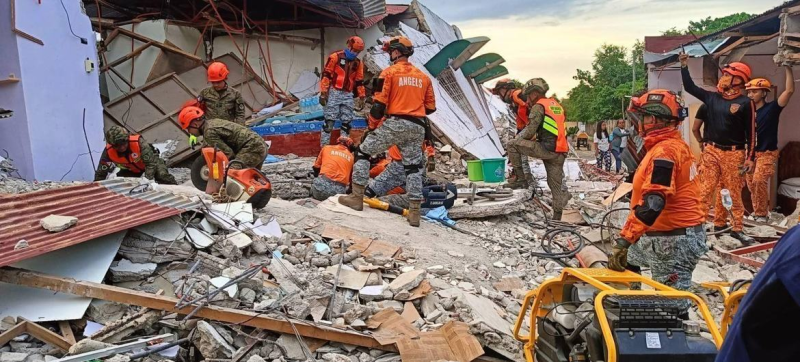- Overnight rain floods Chattogram, causes traffic chaos |
- Khagrachhari violence: 3 cases against 1, 000 unknown people |
- Durga Puja ends today thru immersion of idol |
- Bay Deep depression likely to cross Odisha by Thursday night |
- Human Rights Groups Urged to Unite Against Racism |
Philippines Earthquake: UN Pledges Support as Death Toll Hits 72

Rescue workers in the Philippines search a building in Bogo City, following the earthquake in Cebu.
Hospitals are overwhelmed, and families are sheltering in the open after a deadly 6.9-magnitude earthquake struck northern Cebu in the Philippines, killing at least 70 people and displacing more than 20,000, according to local authorities and humanitarian organizations on the ground.
The tremor struck off the coast of Bogo City at 9:59 PM on Tuesday, 30 September, with the Philippine Institute of Volcanology and Seismology (PHIVOLCS) reporting a shallow depth of around 10 kilometers.
Residents said the quake sent people fleeing into the streets. A tsunami warning was briefly issued and later lifted in the early hours of Wednesday.
The death toll has risen to 72 after search and rescue operations concluded on Wednesday, according to media reports.
More than 200 people were injured in Bogo, Medellin, and San Remigio. Over 111,000 people have been impacted, including 20,000 displaced, many of whom are camped outside their damaged homes or in open spaces as aftershocks continue.
The UN relief coordination office, OCHA, said that Philippine authorities declared a state of emergency across four municipalities, unlocking emergency funds for relief efforts.
The government has also mobilized response teams and set up a joint operations centre.
Initial reports indicate widespread damage to homes, churches, schools, public buildings, and transport infrastructure. At least two seaports remain non-operational, and several roads are partially blocked, hampering aid delivery.
Humanitarian partners report urgent needs, including shelter, water, and access. They are preparing to distribute hygiene kits and water filtration units, while the UN International Organization for Migration (IOM) is on standby to support displaced families.
The disaster has severely impacted health services, with hospitals in northern Cebu stretched beyond capacity and emergency medical teams deployed from neighbouring provinces.
Saia Ma’u Piukala, Regional Director of the World Health Organization (WHO) Western Pacific Office, highlighted the impact:
“The death toll from the September 30 earthquake in Cebu Province has mounted significantly. Hospitals report being overwhelmed with the injured. Our WHO Philippines Country Office is there to support the government-led health response in whatever way is needed.”
More than 340 aftershocks have been recorded since the quake, ranging up to magnitude 4.8. Authorities warn that tremors could continue in the coming days.
The Philippines sits on the Pacific’s so-called “Ring of Fire” and is highly prone to earthquakes, volcanic eruptions, and typhoons.
“The Philippines and many of our other 37 countries and areas are vulnerable to earthquakes and other disasters as a consequence of geography and, increasingly, the climate crisis,” said Regional Director Piukala, urging continued investment in preparedness.
In a statement, the UN Country Team in the Philippines expressed “deepest sympathies and unwavering solidarity” with those affected, praising first responders, medical personnel, and volunteers.

